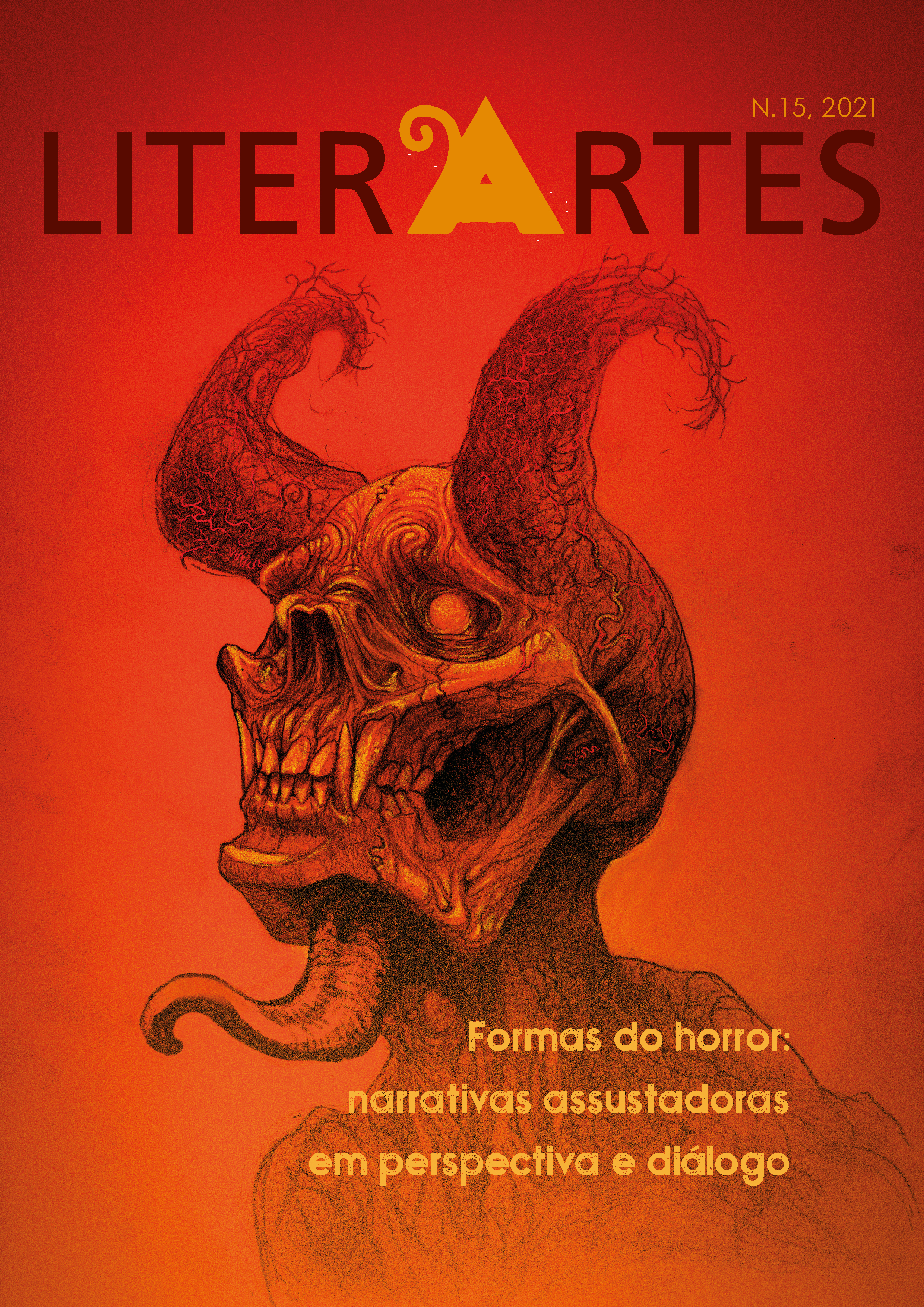Slasher therapy: the slasher movie as an allegory for uncovering trauma
DOI:
https://doi.org/10.11606/issn.2316-9826.literartes.2021.187620Keywords:
Slashers, Trauma, Psychoanalysis, A Nightmare on Elmstreet, Final GirlsAbstract
This study aims at analyzing slasher films as potential allegories for the therapeutic process of uncovering trauma, proposing a reading of the slasher killer as a metaphor for the trauma. To perform this analysis, the plots of the movies A Nightmare on Elm Street (Bayer, 2010) and Final Girls (Schulsson, 2015), were read as possible allegories for a psychoanalytical process in which their final girls come to terms with trauma as they face the killers. This analysis is performed based on the slasher film structure as composed by Final Girl versus Slasher killer, as defined by Carol Clover (1992), and, as their confrontation takes place in what Clover calls the Terrible place, that is compared to the unconscious and its dynamics, as proposed by Sigmund Freud’s The Ego and the Id (2019). The correlation of trauma and fictional narratives is performed based on Cathy Caruth’s (1996) studies of trauma and the construction of narratives.
References
BACHELARD, Gaston. The Poetics of Space. Boston, Massachussetts: Beacon Press Books, 1994.
CARROLL, Noël. The Philosophy of Horror. New York: Routledge, 1990.
CARUTH, Cathy. “The Wound and the Voice”, In: Unclaimed Experience: Trauma, Narrative, and History, The Johns Hopkins University Press, 1996.
CLOVER, Carol, J. Men, Women and Chain Saws: Gender in the modern horror film. Princeton University Press, 1992.
COHEN, J. J. Monster Theory. Minneapolis: University of Minnesota Press, 1996.
DIKA, Vera. GAMES OF TERROR: A DEFINITION, CLASSIFICATION, AND ANALYSIS OF A SUBCLASS OF THE CONTEMPORARY HORROR FILM, THE STALKER FILM, 1978-1981. New York University Ph.D. 1985.
FREUD, Sigmund. “Beyond the Pleasure Principle”. New York: Liveright Publishing Corporation, 1961.
FREUD, Sigmund. The Ego and the Id. New York, NY: Clydesdale Press, 2019.
FREUD, Sigmund. The Interpretation of Dreams. Hertfortshire: Wordsworth Editions, 1997.
FREUD, Sigmund.The Uncanny. Translated and edited by David McLintock. London, England: Penguin Classics, 2003.
HALBERSTAM, Judith. “Bodies that Splatter: Queers and Chain Saws”, In: Skin Shows: Gothic Horror and the Technoogy of Monsters, Duke University Press Durham and London I995.
KING, Stephen. New York, Danse Macabre, NY: Simon and Schuster, 2011, p.13.
STAIGER, Janet. “The Slasher, the Final Girl and the Anti-Denouement”, In: Style and Form in the Hollywood film, ed. Wickham Clayton. Houndsmill, England: Palgrave Macmillan, 2016, pp. 213-281.
ZANINI, Claudio Vescia. “IT HURTS ’CAUSE YOU’RE IN MY WORLD NOW, BITCH”: GOTHIC FEATURES IN THE 1984 AND 2010 VERSIONS OF A NIGHTMARE ON ELM STREET, In: Ilha do Desterro v. 72, nº 1, p. 199-211, Florianópolis, jan/abr 2019.
ZANINI, Claudio Vescia. “O Perverso e o Gótico em Jogos Mortais”. In: Revista Abusões, Rio de Janeiro, n. 1, v. 1, 2015.
Downloads
Published
Issue
Section
License
Copyright (c) 2021 Amanda de Oliveira

This work is licensed under a Creative Commons Attribution-NonCommercial 4.0 International License.
Autores que publicam nesta revista concordam com os seguintes termos:
- Autores mantém os direitos autorais e concedem à revista o direito de primeira publicação, com o trabalho simultaneamente licenciado sob a Licença Creative Commons Attribution que permite o compartilhamento do trabalho com reconhecimento da autoria e publicação inicial nesta revista.
- Autores têm autorização para assumir contratos adicionais separadamente, para distribuição não-exclusiva da versão do trabalho publicada nesta revista (ex.: publicar em repositório institucional ou como capítulo de livro), com reconhecimento de autoria e publicação inicial nesta revista.
- Autores têm permissão e são estimulados a publicar e distribuir seu trabalho online (ex.: em repositórios institucionais ou na sua página pessoal) a qualquer ponto antes ou durante o processo editorial, já que isso pode gerar alterações produtivas, bem como aumentar o impacto e a citação do trabalho publicado (Veja O Efeito do Acesso Livre).



